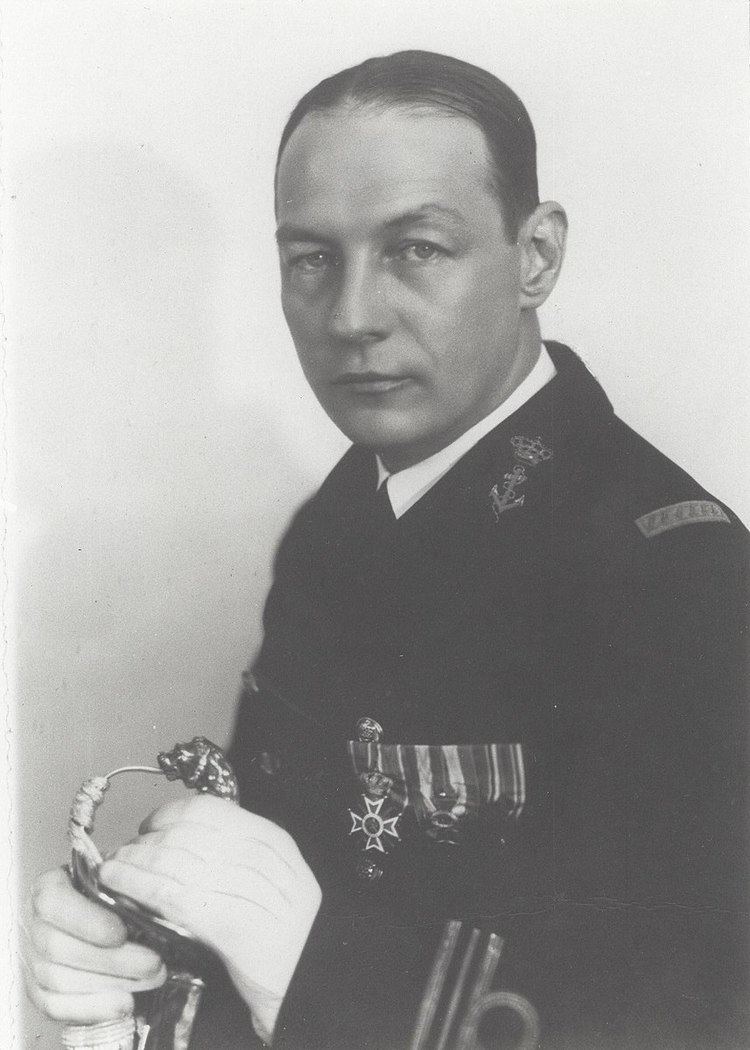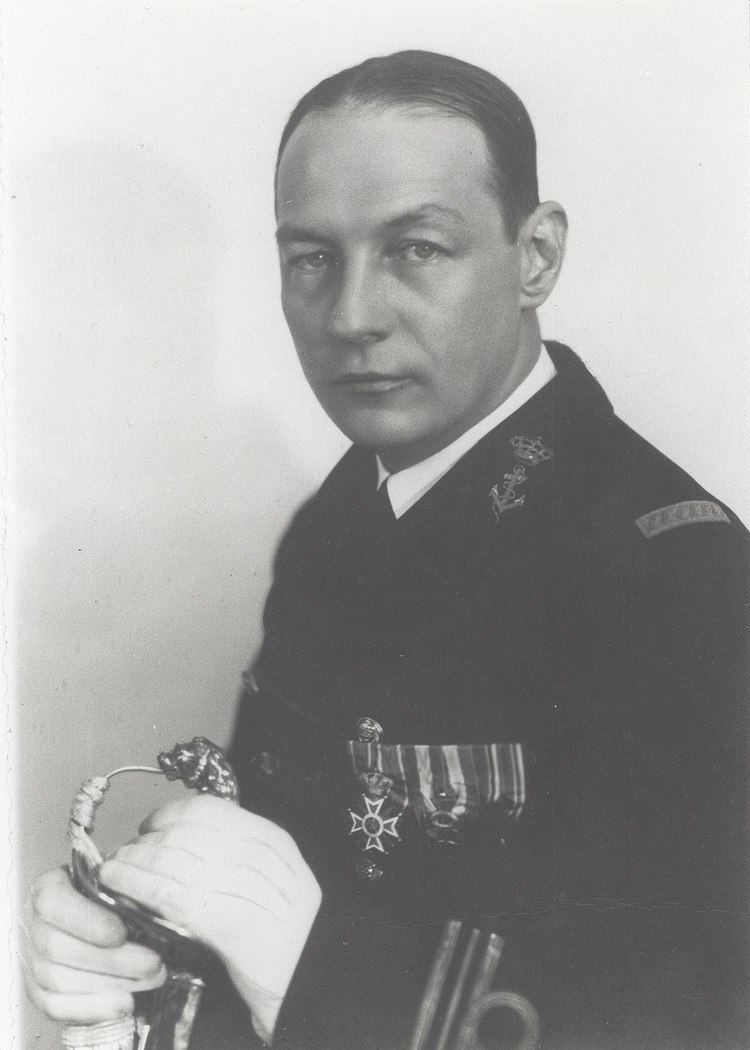Allegiance Netherlands Name Karel Doorman | Years of service 1906–1942 | |
 | ||
Born 23 April 1889Utrecht, Netherlands ( 1889-04-23 ) Commands held Combined Striking Force of ABDAFLOAT | ||
Hnlms karel doorman r81 in hd color 1963
Karel Willem Frederik Marie Doorman (23 April 1889 – 28 February 1942) was a Dutch Rear Admiral who commanded ABDACOM Naval forces, a hastily organized multinational naval force formed to defend the East Indies against an overwhelming Imperial Japanese attack. Doorman was killed and the main body of ABDACOM Naval forces destroyed during the Battle of the Java Sea. In commemoration, the Royal Netherlands Navy named four ships after him: HNLMS Karel Doorman (1946), HNLMS Karel Doorman (1948), HNLMS Karel Doorman (1991) and HNLMS Karel Doorman (2014).
Contents
- Hnlms karel doorman r81 in hd color 1963
- Jss karel doorman stocks up in gibraltar for global ebola effort 19 12 2014
- Youth training active flight period
- Continued career in the Royal Navy commands
- World War II
- I am attacking follow me
- Honours and awards
- References

Jss karel doorman stocks up in gibraltar for global ebola effort 19 12 2014
Youth, training, active flight period
Doorman, born in Utrecht and raised Catholic, came from a family of professional soldiers. In 1906, he and his brother Lou ACM Doorman were commissioned as midshipmen. In 1910 came his promotion to officer rating. In the latter year he moved on board the cruiser Tromp to the Dutch East Indies. During his first three years of duty, from January 1912 to December 1913, he was placed aboard the survey vessels HNLMS van Doorn and HNLMS Lombok, with the primary aim of mapping the coastal waters of New Guinea. Early in 1914 he returned to the Netherlands on board cruiser De Ruyter. In March 1914 he made a request to enter the Aviation Service.
From April 1914 he was placed aboard armored cruiser Noord-Brabant and, just before the first World War broke out, with that ship he was part of a mission to Albania to recover the mortal remains of Major Louis Thomson, who was killed in action there. His request for entry into the Aviation Service was approved in the summer of 1915, after rigorous testing, and he was one of the first naval officers to be awarded his wings.
From 1915 to 1918 he was stationed at the Aviation Service at Soesterberg under command of Captain (later Major) of Engineers H. Walaardt. There he met Albert Plesman, who at first was an observer but later was trained as a pilot in the Army. In 1915 he was awarded a civil pilot licence and in 1916 he was awarded the Naval pilot licence. From 1917 to 1921 he was an instructor, first at Soesterberg Air Base and from October 1918 at the Naval Air Base De Kooy at Den Helder. He commanded this Naval Air Base from 1919 to 1921. Because of his merits as an organizer of the still very young Naval Aviation he was made a Knight of the Order of Orange-Nassau in 1922.
From 1919 to 1934 Doorman was married to Justine A.D. Schermer. In 1928, his son Joop was born; he became a professor of philosophy. There were two other children. After a divorce, he married Isabella J.J.J. Heyligers in 1934. He had one son with her.
Budget cuts and an arm injury meant that Doorman's active flying career was over. From November 1921 to November 1923 he attended Higher Naval School in The Hague, essential for a career as a naval officer, particularly for staff positions. After he successfully completed this training, in which, among other things, he studied communication between aircraft and naval vessels, he was placed at the Department of the Navy at Batavia in December 1923.
Continued career in the Royal Navy, commands
In 1926, for the first time in eleven years, Doorman landed a longer appointment on board a naval vessel, armoured ship De Zeven Provinciën. Until late 1927 he was gunnery officer, later he combined this with the function of first officer. Early in 1928 he returned to the Netherlands and was employed in the Navy Department at The Hague and primarily responsible for the purchase of equipment for Naval Aviation. In 1932 followed his first command of a ship, the minelayer HNLMS Prins van Oranje. In this ship he sailed for the third time in the same year to the Dutch East Indies. In 1932 his command was changed to destroyers, first Witte de With and from the end of 1932, Evertsen. The latter ship saw action against the rebels on HNLMS De Zeven Provinciën in February 1933.
In January 1934 Doorman went back to the Netherlands with Evertsen. A period of three years as Chief of Staff of the naval commander in Den Helder followed. In 1936 Doorman wrote a request to the Secretary of Defense for a command of a cruiser in the Dutch East Indies. As a result, he left in 1937, now a Captain, to the Dutch East Indies as a commander of the cruisers Sumatra and Java. In August 1938 he was appointed Commander of Naval Aviation in the Dutch East Indies. From his headquarters at Surabaya Morokrembangan Naval Air Station, he made many an inspection tour of the archipelago.
World War II
On 16 May 1940, he was promoted to Rear-Admiral and on 13 June 1940 on board the light cruiser De Ruyter, he took command of the squadron of Rear-Admiral GW Stöve at Surabaya. Early 1942 he commanded the Combined Striking Force of ABDACOM, American British Dutch Australian Command.
On February 3, Doorman led a group of ships to stop a Japanese invasion force headed towards Makassar. While en route, his force was observed by the Japanese and bombed, forcing him to turn back after several ships were damaged. This was the Battle of Makassar Strait also known as the Battle of the Flores Sea.
On 18 February, Japanese forces invaded Bali. Doorman led another force attempting to stop the invasion the next day. Due to short notice and unable to concentrate his forces, three waves of counterattacks were planned. The first wave involving cruisers and destroyers was unsuccessful, leading to the sinking of the Dutch destroyer Piet Hein. The second wave of a Dutch cruiser and several American destroyers was also unsuccessful, although causing severe damage to a Japanese destroyer. The third wave of patrol boats encountered no Japanese forces. The failure to stop the Japanese led to the successful occupation of Bali. This engagement is known as the Battle of Badung Strait.
Doorman was killed in action when his ship De Ruyter was sunk in the Battle of the Java Sea. Part of the crew was rescued, but Doorman, following old navy tradition, chose to go down with his ship. On 5 June 1942 he was posthumously made a Knight 3rd class in the Military William Order. The medal was awarded to the Rear-Admiral's eldest son on 23 May 1947 by Lieutenant-Admiral Conrad Emil Lambert Helfrich, on board HNLMS Karel Doorman, attended by Prince Bernhard.
Between 1946 and 2006 the Royal Dutch Navy named three vessels after Karel Doorman, including a former British Colossus-class aircraft carrier, the largest ship the Navy ever commissioned.
"I am attacking, follow me"
Karel Doorman is often honoured because he signalled "Ik val aan, volg mij" ("I am attacking, follow me") during the Battle of the Java Sea, which was considered very gallant. The real explanation is different.
On 27 February 1942, at approximately four in the afternoon, the Japanese and the allied squadrons spotted each other. Karel Doorman notably recognized that the Dutch fleet was smaller than the Japanese, and gallantly proceeded to attack the Japanese fleet and go down with the ship. The guns of the two Japanese cruisers had a longer range than the Allied guns and at about five o'clock the British cruiser HMS Exeter was hit. Twenty minutes later the Dutch destroyer HNLMS Kortenaer was torpedoed. The ship exploded and broke in two pieces. Confusion arose in the Allied squadron over the way forward, compounded by the fact that HMS Exeter could only sail at half power and wanted to return to port at Tanjung Priok on its own steam.
Remembering instructions issued by High Command, Doorman gave the order to attack at the approach of the Japanese fleet. The tactical command "I attack, follow me" as such he did not signal at the beginning of this battle in the Java Sea. It is a very free translation of the signal sent by him, "All ships – follow me", to remedy the confusion. The battle on 27 February 1942 which, with interruptions, lasted for over seven hours, ended with the almost complete destruction of Doorman's squadron. The squadron commander was killed aboard the flagship, which sank after about 1 ½ hours.
The Hague Kloosterkerk has a memorial plaque and commemorations for the Battle of the Java Sea are regularly held.
